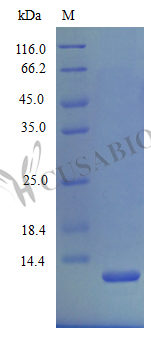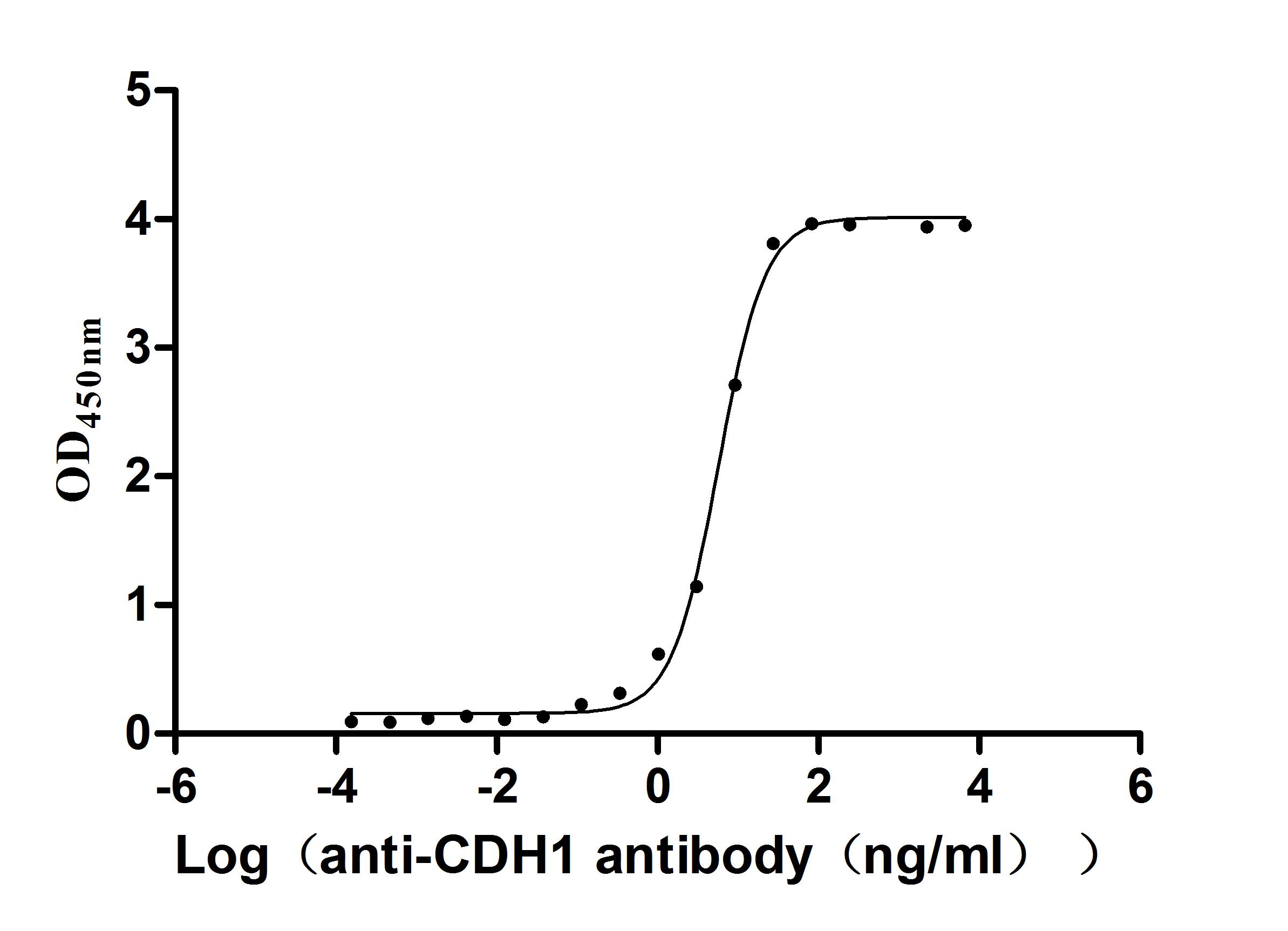Recombinant Mouse C-X-C motif chemokine 2 protein (Cxcl2)
In Stock产品详情
-
纯度:>97% as determined by SDS-PAGE.
-
内毒素:Less than 1.0 EU/μg as determined by LAL method.
-
生物活性:Fully biologically active when compared to standard. The biological activity determined by a chemotaxis bioassay using human neutrophils is in a concentration range of 1.0-10 ng/ml.
-
基因名:
-
Uniprot No.:
-
别名:Cxcl2; Mip-2; Mip2; Scyb2C-X-C motif chemokine 2; Macrophage inflammatory protein 2; MIP2
-
种属:Mus musculus (Mouse)
-
蛋白长度:Full Length of Mature Protein
-
来源:E.Coli
-
分子量:7.8 kDa
-
表达区域:28-100aa
-
氨基酸序列AVVASELRCQ CLKTLPRVDF KNIQSLSVTP PGPHCAQTEV IATLKGGQKVCLDPEAPLVQ KIIQKILNKG KAN
-
蛋白标签:Tag-Free
-
产品提供形式:Liquid or Lyophilized powder
Note: We will preferentially ship the format that we have in stock, however, if you have any special requirement for the format, please remark your requirement when placing the order, we will prepare according to your demand. -
缓冲液:0.2 μm filtered 20 mM PB, pH 7.4, 150 mM NaCl ,lyophilized
-
储存条件:Store at -20°C/-80°C upon receipt, aliquoting is necessary for mutiple use. Avoid repeated freeze-thaw cycles.
-
保质期:The shelf life is related to many factors, storage state, buffer ingredients, storage temperature and the stability of the protein itself.
Generally, the shelf life of liquid form is 6 months at -20°C/-80°C. The shelf life of lyophilized form is 12 months at -20°C/-80°C. -
货期:5-10 business days
-
Datasheet & COA:Please contact us to get it.
相关产品
靶点详情
-
功能:Chemotactic for human polymorphonuclear leukocytes but does not induce chemokinesis or an oxidative burst.
-
基因功能参考文献:
- The studies revealed that, although overall structural and oligomerization features of CXCL3 and CXCL2 are similar, prominent differences were observed in their surface characteristics, thus implicating a functional divergence. PMID: 28928065
- TIARP independently down-regulated CXCL2 and IL-6 production by fibroblast-like synoviocytes, and the expression of chemokine receptors (CXCR1 and CXCR2) in neutrophils, with resultant reduction of neutrophil migration into arthritic joints. PMID: 27995997
- a paracrine role for Hippo-mediated secretion of CXCL1 and CXCL2 in the production of anti-microbial peptides (beta-defensins), iNOS, NOX2 and pro-inflammatory molecules during mycobacterial infection of the host, is reported. PMID: 27883091
- Taken together, the data of the present study demonstrated that TcpC can induce MIP2 production, which may contribute to the characteristic histological change associated with pyelonephritis. PMID: 28765918
- mip-2 siRNA and the MIP-2 antibody can reduce the inflammatory effects induced by lipopolysaccharide in macrophage cells. PMID: 28662496
- this study demonstrates that in vivo blocking of CXCL1 and CXCL2 can significantly reduce the Mycobacterium tuberculosis-induced bioactive IL-1beta production PMID: 28739876
- These data identify suppression of CXCL2 and CXCL5 chemoattractant expression by 11beta-HSD1 as a novel mechanism with potential for regulation of neutrophil recruitment to the injured myocardium, and cardiac fibroblasts as a key site for intracellular glucocorticoid regeneration during acute inflammation following myocardial injury. PMID: 28522730
- findings show that SRC-3 contributes to host defense against enteric bacteria, at least in part via upregulating CXCL2 expression to recruit neutrophils PMID: 28053238
- p53-mediated induction of PAI-1 expression due to chronic CS exposure exacerbates lung inflammation through elaboration of CXCL1, CXCL2, and CXCR2. PMID: 26747783
- Social defeat induced an exposure-dependent increase in mRNA levels of E-selectin, CXCL1, and CXCL2 that increased with additional days of social defeat. PMID: 25445193
- MIP-2 directly impairs neonatal pulmonary endothelial cell migration in vitro. PMID: 26163511
- SIRT2 regulates LPS induced proximal renal tubules CXCL2 protein expression. PMID: 25349202
- miR26a/-26b-COX-2-MIP-2 loop regulates allergic inflammation and the feedback relationship between allergic inflammation and the enhanced tumorigenic and metastatic potential PMID: 25907560
- huH1N1 virus PA and NA mediated increased MIP-2 expression early postinfection, resulting in substantial pulmonary neutrophilia with enhanced lung pathology and disease PMID: 25762737
- Syndecan-1 is expressed in the parietal peritoneum microvasculature but does not regulate leukocyte recruitment and is not necessary for the presentation of the chemokine MIP-2 in this tissue. PMID: 25184228
- Identified TLR2 and S100A8/S100A9 as key regulators of hepatic CXCL-2 expression and neutrophil recruitment. PMID: 24333183
- Suggest anti-inflammatory action of daidzein in lung epithelial cells is mediated via a direct interaction with PARP-1, which inhibits RelA/p65 protein PARylation required for the transcriptional modulation of pro-inflammatory chemokines such as Cxcl2. PMID: 24632845
- suppression of CXCL2 expression may contribute to the beneficial effect of Am80 as a therapeutic agent for intracerebral hemorrhage. PMID: 24659080
- Neutrophil recruitment and the neutrophil cytokines, CXCL1/CXCL2, were suppressed in apo(a)transgenic mice in the abdominal aortic aneurysm model. PMID: 24650562
- These data identify a cytokine circuit that involves IL-1beta-induced production of CXCL1 and CXCL2 and leads the recruitment of neutrophils to streptococcal infection sites. PMID: 25114117
- Data indicate that levels of toll-like receptors TLR4/4-stimulated chemokines CXCL1 and CXCL2 were selectively enhanced in stressed macrophages via receptor-interacting protein kinase 1 (RIPK1). PMID: 24920846
- Commensal bacteria-dependent select expression of CXCL2 contributes to periodontal tissue homeostasis. PMID: 23433011
- these results strongly suggest that both lack of HOCl and accumulation of H2O2 due to MPO deficiency contribute to the up-regulation of MIP-2 production in mouse neutrophils stimulated with zymosan PMID: 23438680
- Interferonalpha stimulates production of maladaptive proinflammatory CXCL2 by renal tubular cells. PMID: 23657854
- the model that mast cells, optimally positioned in close proximity to the vasculature, initiate an early phase of neutrophil recruitment by releasing the chemoattractants CXCL1/CXCL2. PMID: 23645836
- The results of this study suggested that MIP-2gamma mediates the pathogenesis of central nervous system disorders associated with neutrophil infiltration in the brain and decreased GLT-1 activity. PMID: 23234294
- Systemic treatment with CXCL12 promotes a more stable atherosclerotic lesion phenotype and enhances the accumulation of smooth muscle progenitor cells in these lesions without promoting atherosclerosis. PMID: 23393393
- these results suggest that increased production of reactive oxygen species by ATP-stimulated macrophages activates the signalling pathways that promote MIP-2 production which, in turn, induces neutrophil migration PMID: 22564028
- TNF-alfa and CXCL-2 mRNAs is induced in mice infected with Leptospira. PMID: 22342618
- results show that augmentation of the MIP-2/CXCR2 axis by hyperacetylation of histone H3 on the promoter region of MIP-2 and CXCR2 located in the injured peripheral nerve elicits chronic neuroinflammation through neutrophil accumulation PMID: 22135382
- Lipopolysaccharide stimulates the induction of CXCL2 in bone marrow macrophages (BMMs), osteoclast precursors, at the transcription level. PMID: 21507677
- MIP-2/CXCL2 induced by Chlamydia pneumoniae infection may initiate lymphocytic lung infiltration that can have long-term effects on tissue (ectopic lymphoid tissue formation) after clearance of active infection. PMID: 20840653
- Rho-kinase signalling regulates TNF-alpha and CXC chemokine formation as well as lipid peroxidation in the reperfused colon. PMID: 20593289
- The aim of this study was to determine whether acinar cells are a source of KC and MIP-2 and to understand their transcriptional regulation. PMID: 20671197
- ATP increases chemokine CXCL2 production via both NFAT transcription factor and protein kinase C/MAP kinase signaling pathways by purinergic receptor P2X7 stimulation in microglia. PMID: 20477948
- Receptor activator of NF-kappa B ligand-induced CXCL2 in osteoclast (OC) precursors plays a key role in the attachment, migration, differentiation, and function of OCs. PMID: 20357249
- Data show that rotavirus-infected macrophages promote neutrophil chemotaxis in response to rhesus rotavirus type A. PMID: 20234283
- The distribution of the functional IL-8 homologues CXCL1/KC, CXCL2/MIP-2, and CXCL5-6/LIX in resting and inflamed murine vessels, is examined. PMID: 20007247
- Neutralization of inflammatory chemokine MIP-2 (CXCL2/GRO-beta) attenuates the inflammation, weight loss, and clinical presentation of heterologously infected mice without impacting bacterial burden. PMID: 20065113
- These data give strong evidence that TRPC6 operates downstream to CXC-type Gq-protein-coupled chemokine receptors upon stimulation with MIP-2 and is crucial for the arrangement of filamentous actin in migrating neutrophils. PMID: 18983454
- Migration of PMNs to the CNS coincided with increased expression of transcripts specific for the CXCR2 ELR-positive chemokine ligands CXCL1, CXCL2, and CXCL5 within the brain PMID: 19893623
- Neutrophil-directed MIP-2 expression and protein secretion are low at the incisional site during the first 6 hrs after experimental surgical injury and are at a high level 24 hrs following injury. PMID: 11907123
- in study of relevance of chemokine expression to selective migration of t-cells and the disease localization in murine graft-versus-host disease, Mip2 was found to be predominantly expressed in spleen, liver, and skin, and not heart. PMID: 12098066
- Macrophage inflammatory protein-2 regulates corneal neovascularization induced by infection with Pseudomonas aeruginosa PMID: 12121220
- NO generated after administration of E. coli serves as an important proinflammatory signal to up-regulate MIP-2 expression in vivo. PMID: 12165537
- Plasma levelof thisprotein was decreased significantly by clodronic acid-encapsulating liposomes in sepsis induced by P.aeruginosa. PMID: 12604029
- High tidal volume ventilation in absence of underlying injury induces intrapulmonary TNF-alpha and MIP-2 expression in mice. PMID: 12807894
- These data show that macrophage inflammatory protein (MIP-2) is important for hepatocyte proliferation after partial hepatectomy and that pharmacological MIP-2 doses after hepatic injury accelerate hepatic regeneration. PMID: 12875976
- induction of secretion in fibrosarcoma cells by NFkappaB and activation of lymphotoxin beta receptor PMID: 12957791
- CXC chemokines play a fundamental role in colonic ischemia/reperfusion and that functional interference with CXC chemokines may protect against pathological inflammation in the colon PMID: 14583342
显示更多
收起更多
-
亚细胞定位:Secreted.
-
蛋白家族:Intercrine alpha (chemokine CxC) family
-
数据库链接:
KEGG: mmu:20310
STRING: 10090.ENSMUSP00000074885
UniGene: Mm.4979
Most popular with customers
-
Recombinant Human Cell adhesion molecule 1 (CADM1), partial (Active)
Express system: Mammalian cell
Species: Homo sapiens (Human)
-
Recombinant Human Cadherin-1(CDH1),partial (Active)
Express system: Mammalian cell
Species: Homo sapiens (Human)
-
Recombinant Macaca fascicularis Dipeptidase 3(DPEP3) (Active)
Express system: Mammalian cell
Species: Macaca fascicularis (Crab-eating macaque) (Cynomolgus monkey)
















